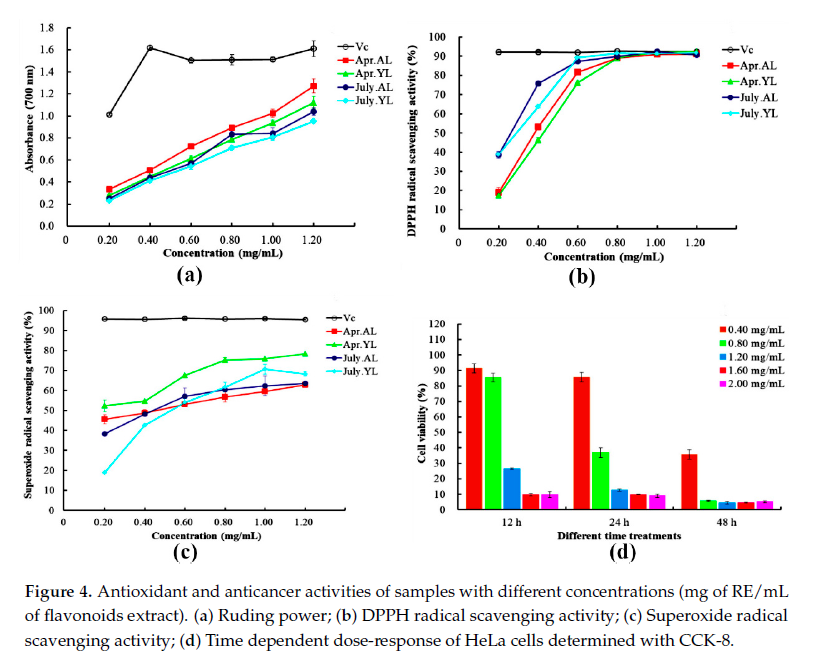BixiaWang 1,2, Jipeng Qu 1,3, Siyuan Luo 1, Shiling Feng 1, Tian Li 1, Ming Yuan 1, Yan Huang 1, Jinqiu Liao 1, Ruiwu Yang 1 and Chunbang Ding 1,*
1 College of Life Sciences, Sichuan Agricultural University, Yaan 625014, China; 696wbx@163.com (B.W.);
ququ8312@163.com (J.Q.); luosiyuan1998@163.com (S.L.);fengshilin@outlook.com (S.F.);
lit@sicau.edu.cn (T.L.); yuanming@sicau.edu.cn (M.Y.); shirley11hy@163.com (Y.H.); liaojinqiu630@sicau.edu.cn (J.L.); yrwu@sicau.edu.cn (R.Y.)
2 College of Environmental Science and Engineering, ChinaWest Normal University, Nanchong 637009, China
3 College of Agricultural Science, Xichang University, Xichang 615000, China
* Correspondence: dcb@sicau.edu.cn; Tel.: +86-083-562-5014
Abstract:
Olea europaea leaves are the major byproduct of olive farming. In this study,ultrasound-assisted extraction of flavonoids from olive leaves was optimized using response surface methodology, and the flavonoid compounds and their antioxidant and anticancer activities were investigated by high performance liquid chromatography. The results showed that the optimized conditions for achieving the maximum yield of flavonoids (74.95 mg RE/g dm) were 50℃temperature, 270 W power, 50 min time, and 41 mL/g liquid-solid ratio. There was a significant difference in the total flavonoid content between the aged and young leaves harvested in April and July, and six main components were quantified. Among them, luteolin-4’-O-glucoside was the most predominant flavonoid compound, followed by apigenin-7-O-glucoside and rutin. Olive leaves also contained small amounts of luteolin, apigenin, and quercetin. Additionally, excellent antioxidant activity was exhibited when tested with the DPPH assay; superoxide radical-scavenging ability and reducing power was also tested. The anticancer activity of the flavonoids was assessed using HeLa cervical cancer cells, and it was observed that increasing concentrations of olive leaf flavonoids resulted in decreased cancer cell viability. These results suggest that the flavonoids from olive leaves could be used as a potential source of natural antioxidants for the pharmaceutical and food industries.

FULL-TEXT:  Optimization of ultrasound-assisted extraction of flavonoids from olive(Olea europaea) leaves, and evaluation of their antioxdant and anticancer activities.pdf
Optimization of ultrasound-assisted extraction of flavonoids from olive(Olea europaea) leaves, and evaluation of their antioxdant and anticancer activities.pdf